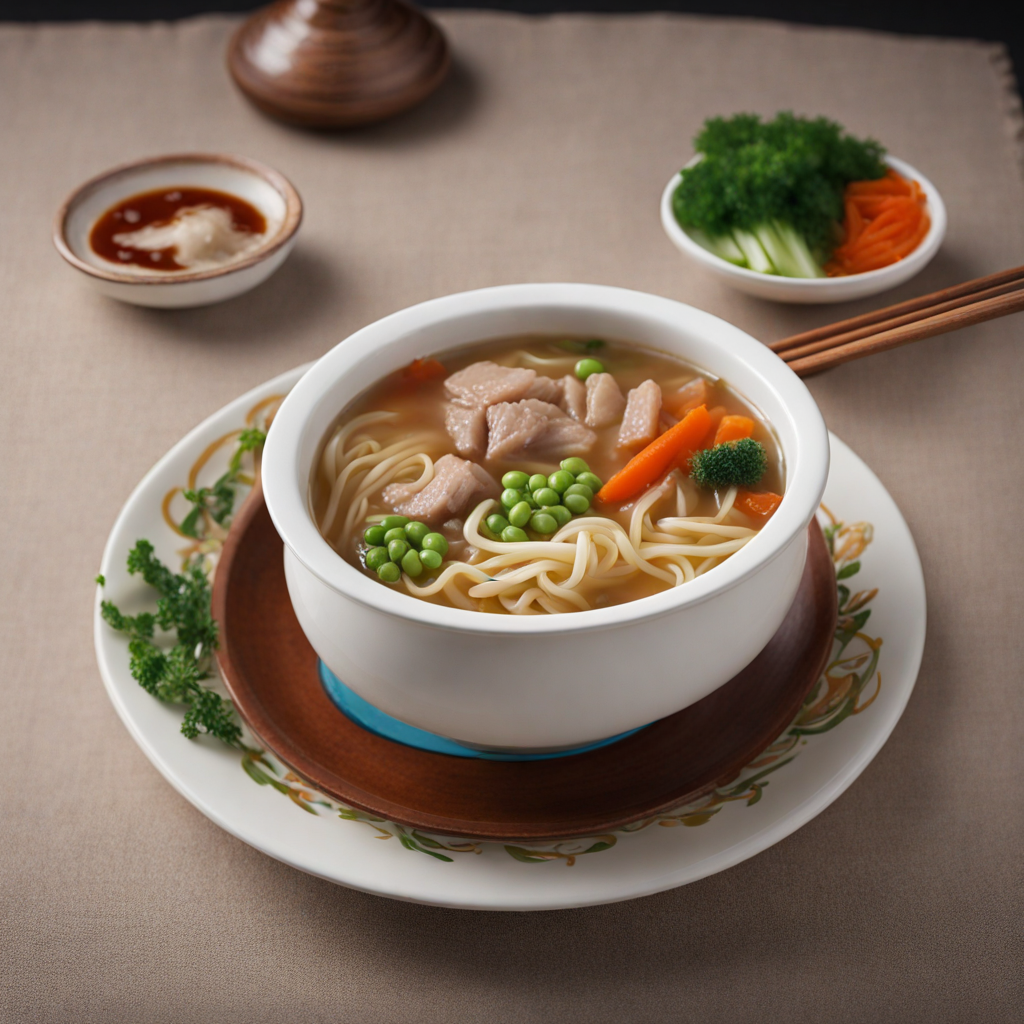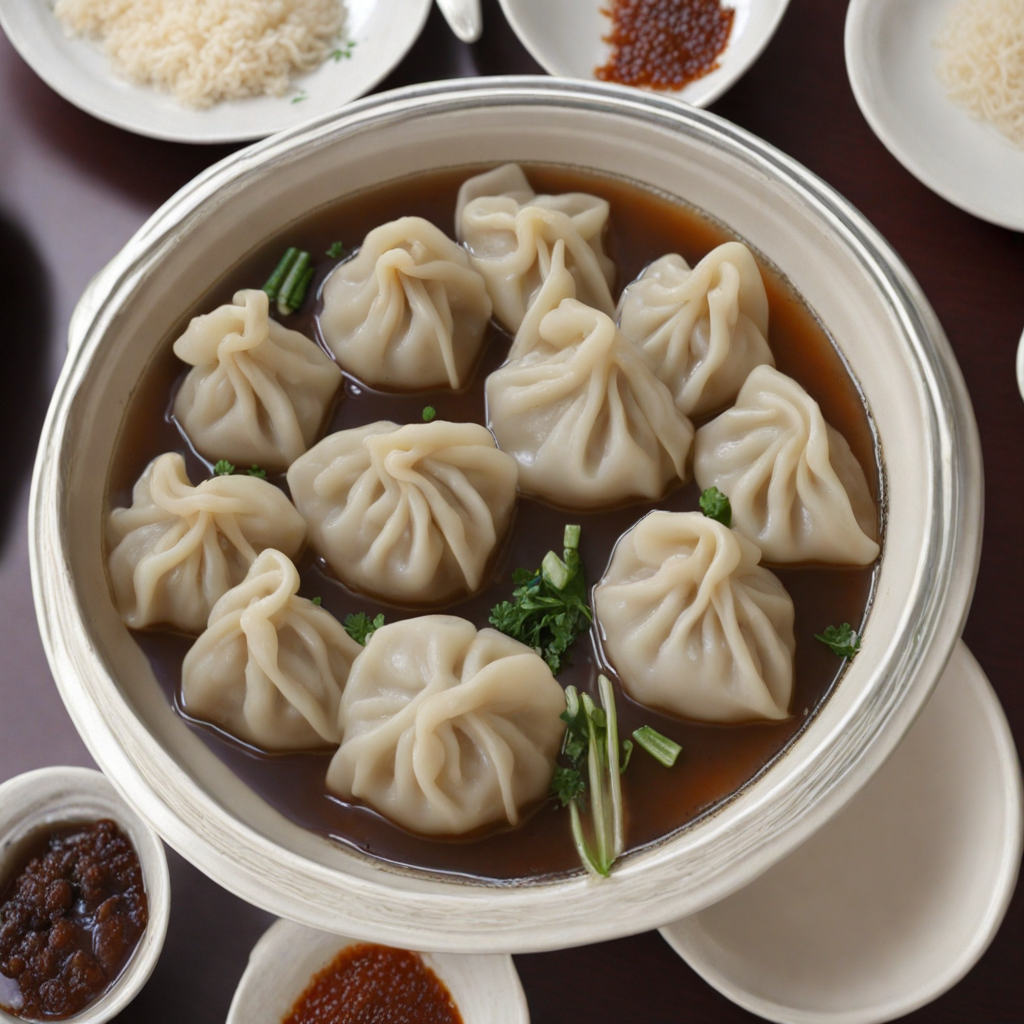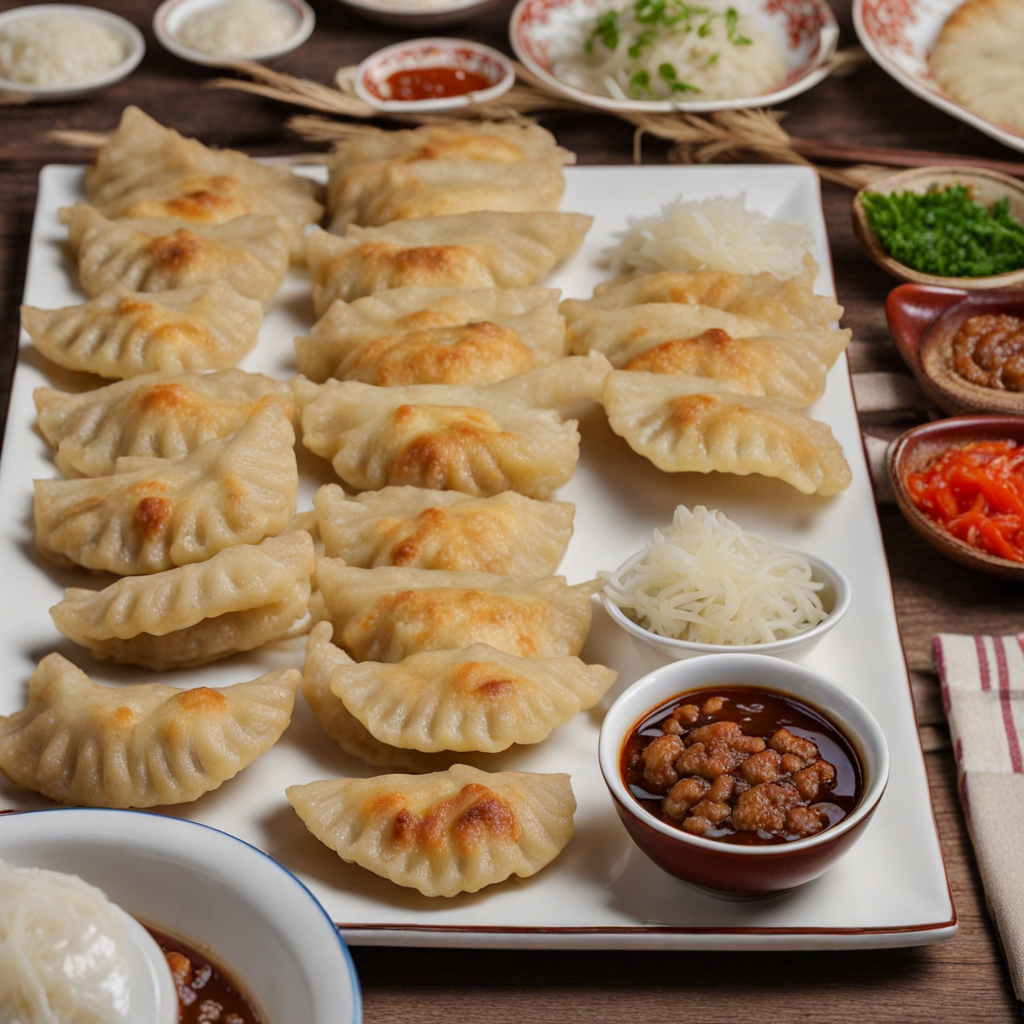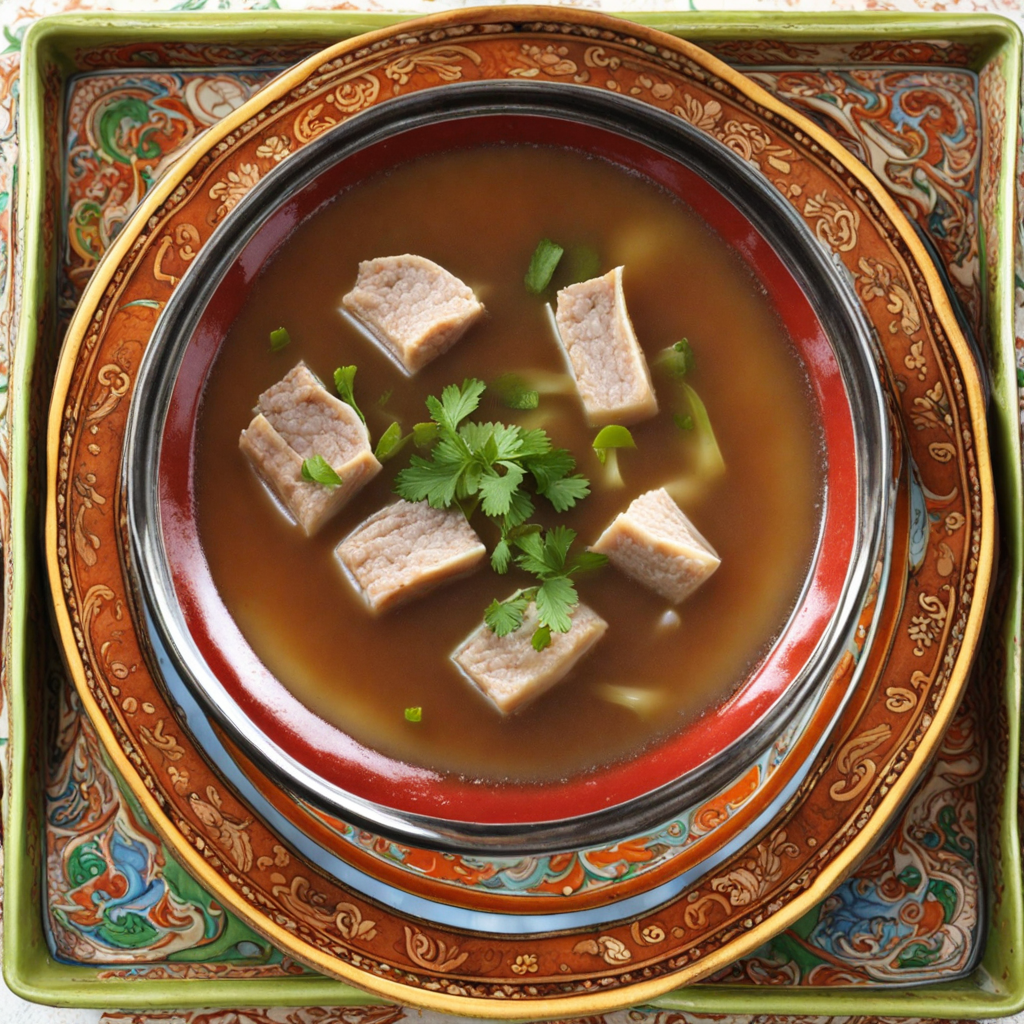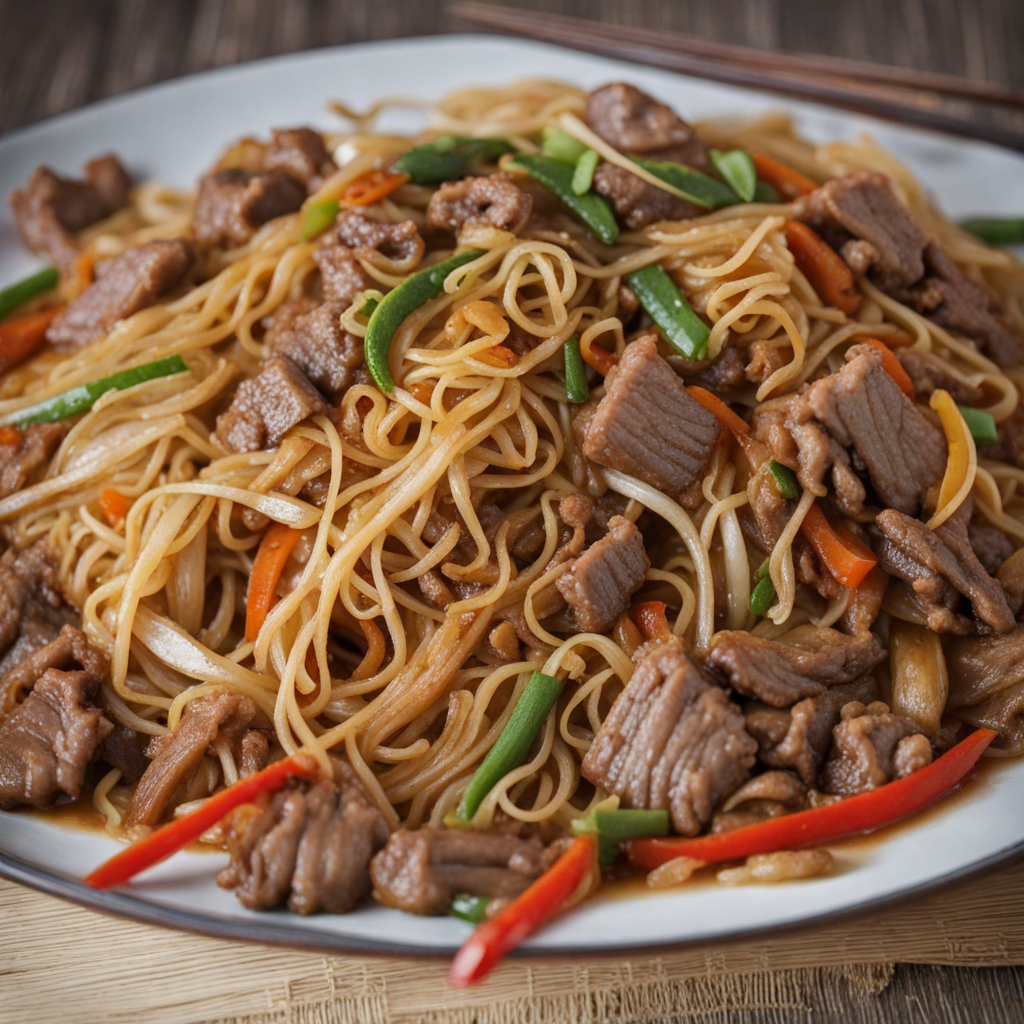Guriltai Shul
Guriltai Shul is a traditional Mongolian noodle soup that beautifully encapsulates the essence of Mongolian cuisine. This hearty dish features hand-pulled noodles, known as 'guriltai', which are made from simple ingredients like flour and water. The noodles are typically thick and chewy, providing a satisfying bite that complements the rich broth. The flavor profile is deeply influenced by the use of lamb or beef, which is simmered slowly to create a savory base. Often infused with garlic, onions, and a hint of spices, the broth is both warming and comforting, making it a staple during the colder months in Mongolia. What sets Guriltai Shul apart is not just its robust flavor but also its communal spirit. This dish is often enjoyed in family gatherings or celebrations, where the preparation and consumption become a shared experience. The noodles are usually added to the broth right before serving, allowing them to soak up the delicious flavors. Garnished with fresh herbs like cilantro or green onions, and sometimes accompanied by a side of pickles or fermented vegetables, each bowl of Guriltai Shul is a culinary adventure that invites you to savor the unique tastes of Mongolian culture. For those looking to explore new flavors, Guriltai Shul offers a delightful interplay of textures and tastes. The silky noodles contrast with the tender pieces of meat, while the broth envelops everything in a comforting warmth. Each spoonful delivers a comforting and hearty experience, perfect for those chilly evenings or whenever you're in need of a flavorful pick-me-up. Discovering Guriltai Shul is not just about tasting a new dish; it's about immersing yourself in the rich traditions of Mongolia, where food is not only sustenance but also a celebration of life and community.
How It Became This Dish
Гурилтай шөл (Guriltai Shöl): A Culinary Journey Through Mongolia Origin and Historical Context Гурилтай шөл, or Guriltai Shöl, is a traditional Mongolian dish that translates to "noodle soup." It is a hearty and nourishing meal that embodies the nomadic lifestyle of the Mongolian people. To understand the origins of Guriltai Shöl, one must delve into the historical and cultural context of Mongolia. Mongolia, known for its vast steppes and harsh climatic conditions, has a long-standing tradition of pastoralism. The Mongolian nomads relied heavily on livestock for sustenance, raising sheep, goats, camels, and yaks. These animals provided not only meat but also milk, which was essential for making dairy products. The harsh winters necessitated meals that were calorically dense and warming, leading to the development of dishes like Guriltai Shöl that could be prepared quickly using available ingredients. The earliest records of noodle-like foods in Mongolia date back to the 13th century, during the time of Genghis Khan. The Mongols were known for their innovative cooking techniques, often incorporating methods learned from the cultures they encountered during their expansive conquests. The use of wheat flour to create noodles likely came from interactions with neighboring regions such as China, where noodle-making has a rich history. Cultural Significance Guriltai Shöl holds a special place in Mongolian culture, serving not just as nourishment but also as a symbol of hospitality and community. The dish is often prepared during gatherings and celebrations, reflecting the warmth and generosity of the Mongolian people. It is common to see Guriltai Shöl served at significant events such as weddings, festivals, and family reunions, where it acts as a unifying force, bringing people together around the communal table. The soup is typically made with simple, accessible ingredients: wheat flour for the noodles, mutton or beef for the broth, and various vegetables such as carrots, potatoes, and onions. These ingredients mirror the nomadic lifestyle, where food is prepared in a way that maximizes the use of available resources. The dish is often flavored with traditional spices like salt and pepper, and sometimes garnished with fresh herbs, adding layers of flavor to the simple yet satisfying meal. In a broader context, Guriltai Shöl reflects the Mongolian ethos of resilience. The ability to create a nourishing meal from minimal ingredients is a testament to the ingenuity and resourcefulness of the nomadic people. This dish is not just a meal; it is a celebration of survival in a landscape that can be both beautiful and unforgiving. Development Over Time As the years progressed, Guriltai Shöl evolved alongside the changing lifestyle and culinary practices of the Mongolian people. The introduction of modern cooking techniques and the influence of globalization have led to variations in the traditional recipe, yet the essence of the dish remains intact. In urban areas, where access to diverse ingredients has increased, Guriltai Shöl has seen a fusion of flavors and styles. Chefs have begun to incorporate different meats beyond the traditional mutton and beef, including chicken and even seafood, appealing to a younger generation that seeks new culinary experiences. Additionally, the use of various spices and condiments has expanded, allowing for a more complex flavor profile that caters to contemporary palates. Moreover, the rise of the food tourism industry in Mongolia has brought Guriltai Shöl to the attention of international visitors. Travelers seeking authentic culinary experiences have made this dish a staple in Mongolian restaurants, where it is often showcased as a must-try dish. This exposure has not only elevated the status of Guriltai Shöl but has also contributed to the preservation of Mongolian food traditions. In recent years, there has been a renewed interest in traditional Mongolian cuisine, spurred by movements promoting local ingredients and sustainable cooking practices. Guriltai Shöl fits perfectly into this narrative, as it encourages the use of locally sourced meats and vegetables, fostering a connection between the land and the food. Many Mongolian families take pride in preparing this dish from scratch, hand-rolling the noodles and simmering the broth to create a meal that honors their heritage. Conclusion Guriltai Shöl is much more than just a noodle soup; it is a reflection of Mongolia's rich history, cultural identity, and the enduring spirit of its people. From its origins in the nomadic lifestyle to its place on the modern dining table, this dish tells the story of resilience, community, and the connection between food and culture. As the world becomes increasingly homogenized, the importance of preserving traditional dishes like Guriltai Shöl grows. It serves not only as a delicious meal but also as a reminder of the importance of heritage, community, and the stories that food can tell. Whether enjoyed in the heart of the Mongolian steppe or in a bustling urban restaurant, Guriltai Shöl continues to bridge the past and the present, offering a taste of Mongolia’s rich culinary landscape to all who partake in it.
You may like
Discover local flavors from Mongolia



